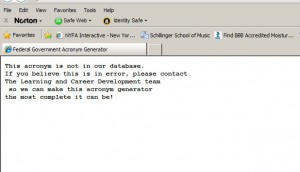This is how I feel right about now as we make the final push toward the end of the semester over the next three weeks .
This next week will be the worst for me as I prep for the PCA/ACA conference around our classwork, my job and a boatload of driving between DC, NY, and Boston.
I’m not complaining; this is just part of what I’m processing this week. It’s all good.
Cognitive Surplus by Clay Shirky, Part 3
The Shirky book is definitely different than I expected. Shirky concentrates on the possibilities of aggregating global free time to the personal, communal, public and civic good. However, he never really addresses what the response should be when there are groups out there that gather around ignoble causes, such as anarchy or crime. I am convinced that trafficking and slavery have increased simply because the like-minded can find each other, organize and coordinate their efforts just as easily as the more civic-minded.
Shirky’s book focuses primarily on groups that are interested in pursuing more useful goals and tasks, such as carpooling (pickuppal.com), meeting like-minded (meetup.com), archiving knowledge (Wikipedia), creating the Apache system or creating software for particular civic purposes (Ushahidi). I suppose when you’re trying to present the beneficial possibilities, as did Thomas L. Friedman in The World is Flat, Shirky decided that it wasn’t the purpose of the book to put the skids on the underbelly of these advancements. He could be leaving room for someone else to complete that part of the picture, or leave room for a sequel (although I doubt the latter).
The closest Shirky comes to addressing possible dangers, concerns couchsurfing.com, a service that offers free travel accommodation in private homes all around the world (165). Of course, traveling women who stay in the homes of strange men are subject to incredible risks. However, Shirky seems to think the way the couch surfing community is structured minimizes these risks.
Shirky contrasts the safety of “couch surfing” against a tragic “artistic” experiment of trust entitled “Brides on Tour.” This blog entry does a good job at explaining the “Brides on Tour” tragedy: http://www.madsilence.wordpress.com/tag/brides-on-tour/
Shirky concludes where “Brides on Tour” went wrong was that “an oddly and ostentatiously dressed woman, hitchhiking alone, in a foreign country–what was she thinking? …Between the artists and the couch surfers, the artists were taking the bigger risk, and they were taking it because they believed, wrongly, that human motivations are basically benign… Couchsurfing.com helps travelers find hosts and vice versa, but the site also includes host profiles, a reputation system like eBay’s for hosts, and lots of advice about safety, particularly for female travelers” (168).
Although couchsurfing.com sounds better than just going out on the road alone and meeting people along the way, I still don’t know that couch surfing offers a 100% fool-proof system to make me feel completely comfortable with it.
You be the judge.
Interview with Daniel Hoffer, co-creator of couchsurfing.com
An interesting video on a couch surfer’s musing on how to establish trust between strangers.
New Media Project
As for the new media project, I’ve still got my eye on creating the framework for an expandable acronym generator. In essence this is really a type of dictionary, where people enter letters and an explanation pops up.
Currently, I know how to create an if/else statement for each acronym if it’s typed in one particular case. I can enter case and acronym as separate lines in the code.
However, I realize this isn’t the most efficient, tight code it could be. I’d like to get the loop through one list of acronyms. I’d also like it to be not important if someone types in either upper or lower case letter.
At least at this point, something pops up when a user answers the alert prompt that comes up when you click on the words Acronym Generator. I’m also happy that I have a generic “not in our database” response if someone enters something not in the system. I’d also like to add a “mailto” option so if anything is missing, people can click right from the same page to tell the administrators that something is missing.
Works Cited
Friedman, T.L. (2005). The World is Flat. New York: Farrar, Straus and Giroux.
Shirky, C. (2010). Cognitive Surplus: How Technology Makes Consumers into Collaborators. New York: Penguin Books.




I like that you are sharing your progress so far; however, I’d like a more detailed outline of what/how you want this to function. Something like:
User Inputs:
Application does
1
2
3
Application spits out ____ result
You might even have 2-3 outlines; your dream of what this could do and what you imagine yourself able to code this first time through.
Keep up the hard work!
The way I’d like my acronym generator to work is the following:
1. User comes to a webpage with “Acronym Generator” link on it.
2. User clicks it and reveals a prompt in the form of a popup alert (see my first image above).
3. User types in an acronym, like “ABC” and clicks OK.
4. The internal code does a search within itself (not across any outside lists) to find “ABC.” If the user types in ABC, then a new webpage will appear stating “ABC: American Broadcasting System.”
5. If the user types in an acronym that is not inside the code, then the next webpage will state what is in the second image above stating it’s not in the database.
My goals are simple:
1. To have an at-the-ready, just-in-time, interactive acronym generator.
2. Whenever an employee encounters a new acronym used on the job, then they know where to go and won’t have to search through a long list of names, but just enter the one acronym and up the definition will appear.
3. If an acronym is not in there, the user will have a place to go to request that information be added.
Hope this clarifies my goals and the generator’s interactivity.
Perfect! This is exactly what I needed. 🙂